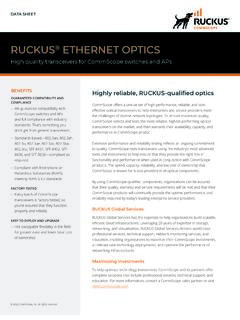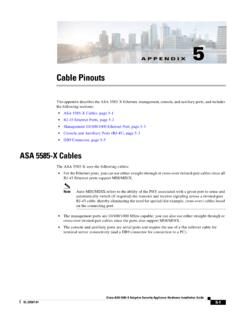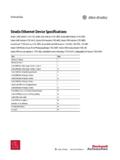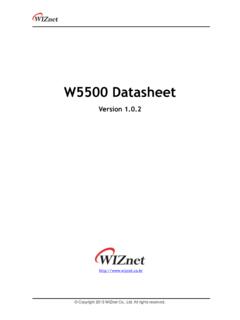Transcription of Time-Sensitive Networking: A Technical Introduction …
1 Time-Sensitive networking : A Technical IntroductionWhite PaperCisco Public 2017 Cisco and/or its affiliates. All rights networking : A Technical IntroductionTime- sensitive networking : A Technical IntroductionWhite PaperCisco Public 2017 Cisco and/or its affiliates. All rights is Time-Sensitive networking (TSN)? In its simplest form, TSN is the IEEE defined standard technology to provide deterministic messaging on standard ethernet . TSN technology is centrally managed and delivers guarantees of delivery and minimized jitter using time scheduling for those real-time applications that require determinism. TSN is a Layer 2 technology. The IEEE standards work at OSI Layer 2. TSN is an ethernet standard, not an Internet Protocol standard. The forwarding decisions made by the TSN bridges use the ethernet header contents, not the IP address.
2 The payloads of the ethernet frames can be anything and are not limited to Internet Protocol. This means that TSN can be used in any environment and can carry the payload of any industrial was developed to enable deterministic communication on standard ethernet . The market for deterministic communication is using nonstandard technologies or nonstandard ethernet . Prior to the IEEE TSN standards, standard ethernet didn t have pure Layer 2 deterministic capability. Deterministic communication is important to multiple industries (for example, aerospace, automotive, manufacturing, transportation, and utilities). Providing a means for determinism over standard ethernet enables new levels of connectivity and optimization, leading to cost savings for many short document is intended to give the interested reader more Technical details about TSN and an Introduction to the Cisco the name suggests, time is the primary aspect of TSN.
3 TSN is a technology focused on time. TSN was developed to provide a way to make sure information can travel from point A to point B in a fixed and predictable amount of time. Being predictable enables increased s an implied requirement for those networking devices implementing TSN (end devices and bridges) to share a common sense of time. Precision Time Protocol (PTP) is used to maintain a common sense of time. The PTP profiles chosen to work with TSN are IEEE and IEEE networking : A Technical IntroductionWhite PaperCisco Public 2017 Cisco and/or its affiliates. All rights Solution ComponentsThere are five main components in the TSN solution: TSN flow: Term used to describe the time-critical communication between end devices. Each flow has strict time requirements that the networking devices honor.
4 Each TSN flow is uniquely identified by the network devices. End devices: These are the source and destinations of the TSN flows. The end devices are running an application that requires deterministic communication. These are also referred to as talkers and listeners. Bridges: Also referred as ethernet switches. For TSN, these are special bridges capable of transmitting the ethernet frames of a TSN flow on a schedule and receiving ethernet frames of a TSN flow according to a schedule. Central network controller (CNC): For TSN, the CNC acts as a proxy for the Network (the TSN Bridges and their interconnections) and the control applications that require deterministic communication. The CNC defines the schedule on which all TSN frames are transmitted. The CNC application is provided by the vendor of the TSN bridges.
5 Cisco has developed a CNC application for controlling its TSN bridges for TSN. Centralized user configuration (CUC): An application that communicates with the CNC and the end devices. The CUC represents the control applications and the end devices. The CUC makes requests to the CNC for deterministic communication (TSN flows) with specific requirements for those flows. The CUC is an application that is vendor specific. Typically the vendor of the TSN end devices will supply a CUC for those end 1 describes TSN 1. TSN StandardsStandardArea of DefinitionTitle of StandardIEEE , IEEE 1588 Timing and synchronizationEnhancements and performance improvementsIEEE and IEEE and queuingFrame preemptionIEEE and queuingEnhancements for scheduled trafficIEEE control and reservationPath control and reservationIEEE configuration methodEnhancements and performance improvementsIEEE ingress policingPer-stream filtering and policingIEEE redundancyFrame replication and elimination for reliabilityNot all standards shown in Table 1 are required to support TSN.
6 Cisco s initial implementation uses , (predecessor to ), and Time-Sensitive networking : A Technical IntroductionWhite PaperCisco Public 2017 Cisco and/or its affiliates. All rights Shared Concept of TimeThe key to providing determinism is a shared concept of time. The implementation of (and in the future ) by all network elements (end devices and bridges) is required for TSN. The PTP profile allows all TSN network elements to share the same concept of time. The key to providing on-time delivery of TSN frames is Qbv defines a means to transmit certain TSN ethernet frames on a schedule, while allowing non-TSN ethernet frames to be transmitted on a best effort basis around the TSN frames. Because all network elements share the same time, end devices and bridges implementing Qbv can deliver critical communication very quickly and with no discernible jitter in good analogy for IEEE is a train system.
7 Think of the ethernet bridges as cities and the links between Brides as train tracks between the There is one track between each city. Trains go from one city to another based on a schedule. The train from city A to city X is scheduled well in advance. Although there are many cities and destinations, there are is only one track between two adjacent cities (just like the cat5 cabling between two ethernet bridges). The track is the scarce resource that has to be time shared. Two trains cannot be on the track at the same time. The train system schedules the departure time for each train from a station, making sure that the track is well used and there are no conflicts. With TSN, the ethernet bridges allow for use of the links to unscheduled traffic when there is no scheduled traffic. For the train system, this could be the regional and local trains using the tracks when the intracity trains are not using is focused on definition of management interfaces and protocols to enable TSN network administration.
8 Is a large specification with many aspects. Cisco is using the centralized approach to network management defined in Overview of Cisco TSN SolutionCisco is supporting TSN on the IE-4000 product family. All models of IE-4000 support TSN. Starting with Cisco IOS Software release (5)E2, the TSN functionality is available. The IE-4000s have an FPGA in the data path that enable them to support TSN. The IE-4000 operates as a TSN bridge. The IE-4000 implements IEEE and IEEE The IE-4000 supports hundreds of TSN flows across its ethernet interfaces. As the name suggests, the TSN central network controller (CNC) controls the TSN bridges in the network. The CNC is a software application running on customer premises (as opposed to cloud). The hardware housing the CNC application is not relevant and can be anything.
9 The CNC has two primary responsibilities. First, it is responsible for determining routes and scheduling the TSN flows through the bridged network. Second, it is responsible for configuring the TSN bridges for TSN CNC communicates with the CUC to receive the communications requirements that the network must provide. The CNC aggregates all the requests, computes the route for each communication request, schedules the end-to-end transmission for each TSN flow, and finally transfers the computed schedule to each TSN bridge. As part of the schedule computation, the CNC provides a unique identifier for each TSN flow. This unique identifier is used by the TSN bridges to differentiate one TSN flow from another. The unique identifier includes the destination MAC address, VLAN ID, and CoS value. With these three items, the TSN bridges can identify the TSN flow and transmit the flow based on the correct Figure 1, you can see all the components and how they relate.
10 The CUC communicates with the CNC using REST APIs. The CNC communicates with both CUC and TSN bridges. The CUC communicates with the talker/listener end devices. The TSN bridges switch the TSN communication ethernet packets between the talkers and listeners. Time-Sensitive networking : A Technical IntroductionWhite PaperCisco Public 2017 Cisco and/or its affiliates. All rights 1. Sample Topology for TSN networking Components TSN Bridge TSN Bridge TSN ow TL/1 and TL/2 CUCTL/1TL/2 CNCREST APIsSchedulerThe APIs between the CUC and CNC are defined and available as part of the Cisco TSN documentation. The APIs are there for everything needed by the CUC to completely program the TSN flows in the network. The APIs are so complete, the CUC can hide the CNC and the network. It s possible for the control engineer to interface with the CUC only, never actively using the CNC or configuring a TSN bridge.














